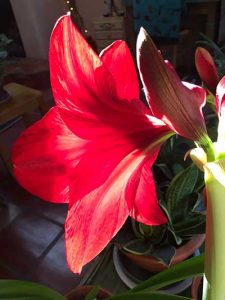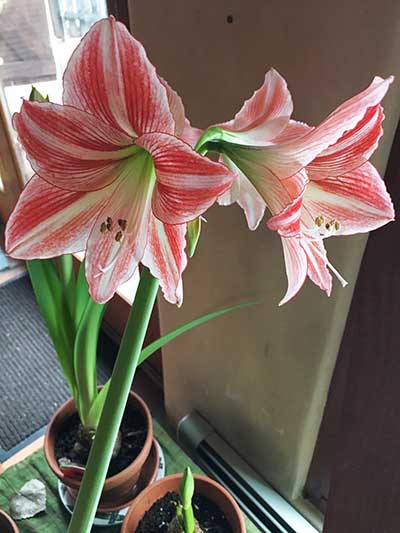 One of my favorite autumn rituals is to go to the nursery in October and buy amaryllis bulbs. This year I splurged and got 9 of them!
One of my favorite autumn rituals is to go to the nursery in October and buy amaryllis bulbs. This year I splurged and got 9 of them!
I pot each bulb, upper part uncovered, place it near the window, carefully water as needed—and wait and wait. I intently scrutinize each bulb every morning, wondering if it will really grow. Weeks go by, and nothing happens. Then one day I see the very tip of a succulent, glossy flower stalk inching up out of one of the bulbs. Days later I see this on another bulb, then another. Then slender new leaf tips gradually appear. With exquisite slowness, this year’s amaryllis flowers come to life. By Christmas, I’m starting to enjoy a dazzling progression of flowers of all sizes, shapes and colors.
What are these plump, beguiling bulbs doing as they while away the weeks in their pots? They are growing roots! Each bulb comes with a brittle thatch of dried-up roots on its bottom, but it must grow new ones when it is planted. And, while it is completely occupied with growing its roots, absolutely nothing new shows on the part of the bulb above the soil’s surface.
Growing roots is the most important step in any plant’s development. We all know that roots are responsible for bringing up water to a plant, but roots do much more than this. Through complex interactions with the soil (itself a living organism), with mycorrhizal fungi and with nearby plants, roots nourish a plant in every way. Plants also absorb water, air and food, as well as crucial sunlight, from their above-ground surroundings, but without roots a plant will soon die.
It struck me this year that my amaryllis plants embody an important lesson for us modern humans. Indigenous people (including our own ancestors) are strongly rooted in their place on Earth. Their lives are ordered and inspired by the seasons, landforms, and physical and spiritual beings where they live. Their primary value is long-term stability. They honor and heed the community’s elders. Their lives are focused on cultivating resilient mutuality with both human and nonhuman beings. None of this can happen without deep roots in the land and its associated ancestral traditions, which are often thousands of years old.
In the modern human-centered world, the primary values are continual growth, increasing speed and endless short-term change. “Progress” is narrowly defined as more stuff and greater comfort. The “gross national product” is the measure of how quickly and successfully the land’s resources are transformed into human-defined usefulness, leaving waste and destruction behind. Anyone middle-aged or older is deemed out of touch and irrelevant, especially the universally ridiculed “boomers.”
All in all, it’s obvious that people living within the currently-dominant culture don’t have roots anymore. Indeed, the perpetuation of the human-created world depends on people not having roots. Meanwhile, both humanity and the natural world are being deprived of essential nourishment, and are steadily becoming more degraded and impoverished.
all, it’s obvious that people living within the currently-dominant culture don’t have roots anymore. Indeed, the perpetuation of the human-created world depends on people not having roots. Meanwhile, both humanity and the natural world are being deprived of essential nourishment, and are steadily becoming more degraded and impoverished.
The good news is that, despite the seemingly iron grip of the modern culture, we humans, deep within ourselves, know who we are and what we truly need. Without roots, however, it’s close to impossible to bring our natural impulses to connect and share—to respectfully, joyfully co-create with Gaia and her human and non-human inhabitants—up into the surface of our lives.
Beginning this holiday season, let’s include in our sacred work a conscious practice of growing spiritual roots down into the land where we live. After all, the Winter Solstice marks the time of greatest darkness. This is understood in ancestral traditions to be the fertile darkness of the Underworld, a vast cauldron that contains powerful energies of rebirth and regeneration. What a perfect time for us to be nourished by this deep, vibrant well of creativity and fecundity beneath our feet.
Let’s all aspire to be like amaryllis bulbs this winter season: full of juicy potential almost ready to surface, but patiently waiting until we grow our roots before we sprout beautiful flowers of hope, peace and regeneration for our hungry, yearning world.
